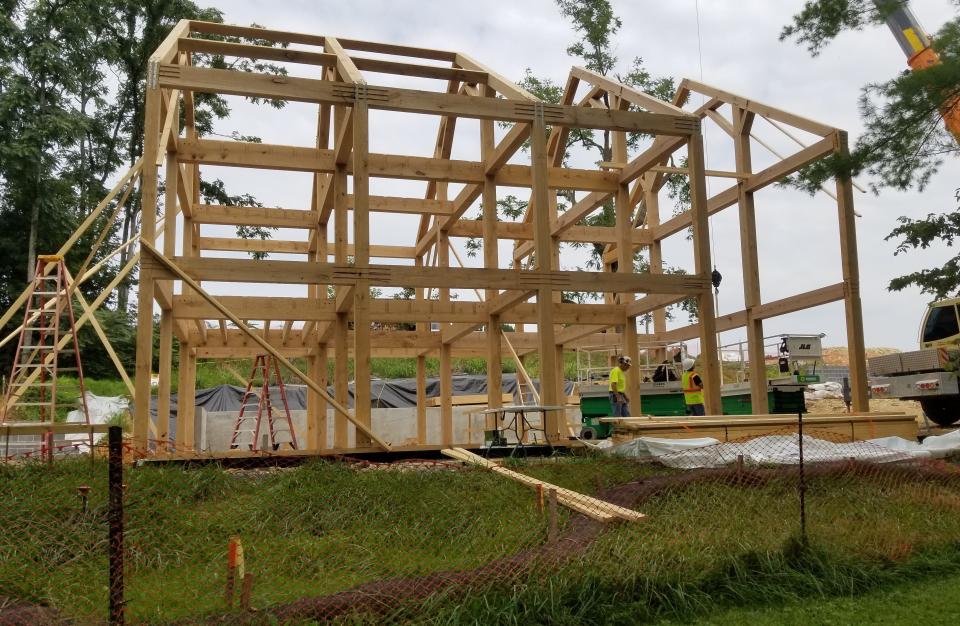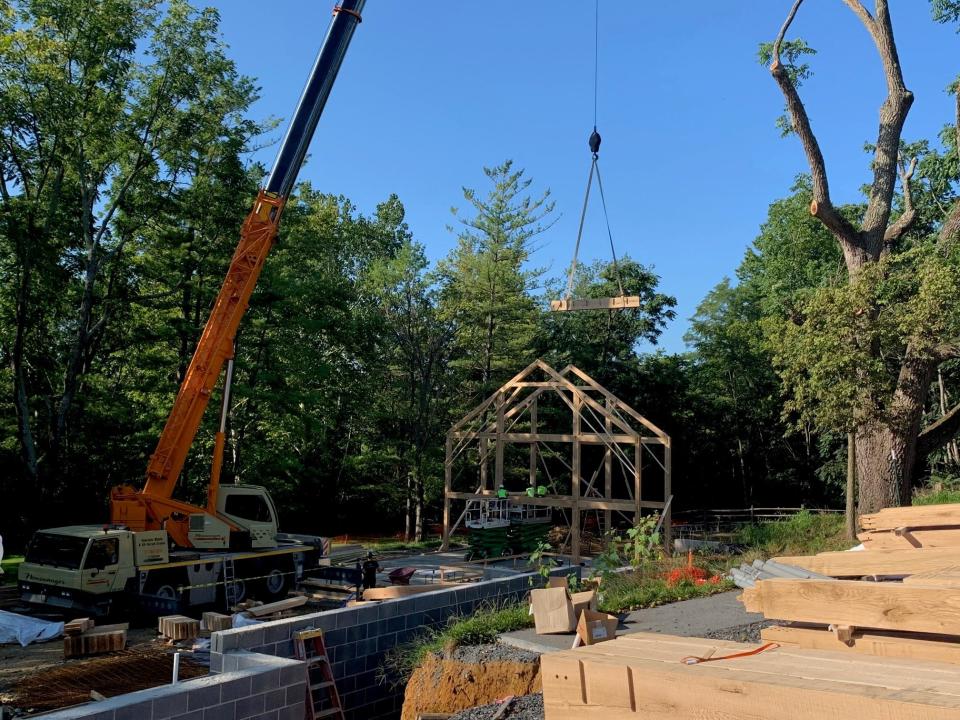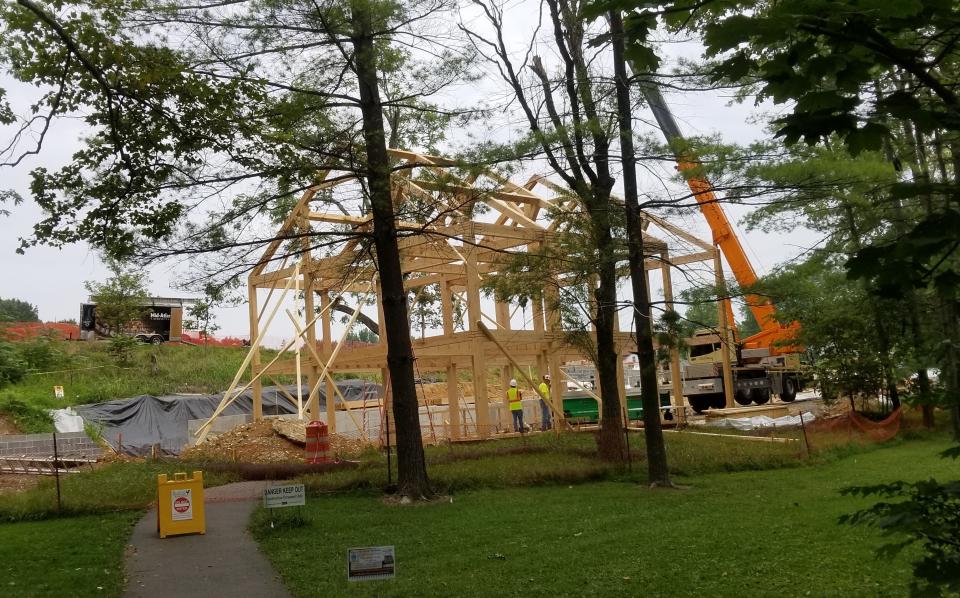New grist for an old mill: History is being built at Renfrew Museum and Park
History in the making can be seen at Renfrew Museum and Park in Waynesboro.
A crane started placing the timber frame for a recreation of the site’s 1800s gristmill at the Pennsylvania German farmstead Aug. 16.
Visitors can watch as the framing and roof trusses are installed and tied together over the next several weeks.
The bloodiest day: Reopened Antietam visitor center to show 'causes … consequences of the American Civil War'
The original gristmill was an important feature of the property, constructing an operational mill has been a goal in Renfrew’s strategic plan for a number of years and it was the focus of a 2019 Gristmill Feasibility Study.
Utility and site work started in fall of 2022, a ground-breaking ceremony was held April 15, 2023, during Renfrew’s 48th opening day celebration and foundation work started in the spring.
“The new Renfrew Mill building, to be located north of the ruins of the historic Royer Mill, will be a three-story structure with fully functioning millworks driven by a single waterwheel,” according to Renfrew Executive Director Becky LaBarre. “The project is proposed in two phases. First, we will erect a three-story structure and pump house about 50 feet from the original foundation. Then a historic millwright and his team will custom-build wooden millworks, bringing the whole operation to life.”
The mission of Renfrew Museum and Park is to preserve, enhance, promote and interpret the Royer family’s Pennsylvania German farmstead and the Nicodemus and Bell pottery collections. It has been open to the public since 1975 and features a number of historic structures.
“The physical presence of an interpretive mill structure, combined with the sensory experience of hearing and seeing the actual moving millworks, has the power to transport visitors back in time to the 1800s,” says the Renfrew website. “A full-scale operation will aid guests’ understanding of the process of milling grain or tanning leather using the hydropower of the Little Antietam Creek.”

“The rebirth of Renfrew’s lost gristmill in its new form has the potential to enhance the interpretation of Renfrew’s story and to give the Waynesboro community, and Renfrew’s estimated 75,000 visitors, an exceptional interpretive experience,” noted Dade Royer, an eighth-generation descendant of the Royer family and member of the Renfrew board.
What’s the history of the Royer Mill?
The Royer gristmill, a three-story structure built by Pennsylvania German tanner Daniel Royer in 1807 of stone, brick and wood, was located at the southern end of the farmstead on the west bank of Little Antietam Creek.
Two 14-foot overwheels powered two sets of grindstones: one set for milling grain and one for inedible industrial materials, such as tanbark and lime, used in the leather tanning process, according to the website. A milldam near the footbridge to the Royer house at the northern end of the farmstead diverted water into a 1,200-foot-long headrace. The water dropped from the millrace onto the overwheels, providing the force to turn the gears that operated the millstones. After passing over the wheels, the water was channeled back into the creek through a 1,000-foot tailrace.

The mill operated until the 1870s when Royer’s grandson, A.J. Fahnestock, tried unsuccessfully to turn the building into a creamery when many area farms were making the switch to commercial dairy production.
It was razed by a subsequent owner, Dr. Abraham Strickler, in the early 20th century.
What’s ahead for the Renfrew Mill?
The first phase of construction is expected to be finished by early 2024, LaBarre said. Phase I includes the mill building envelope — including the structure, masonry, windows, doors, roof and mechanicals — and an adjacent pumphouse/restroom structure.
“We are developing an interpretive plan and preparing for the building shell to be available for occasional tours and Phase II campaign-related events during Renfrew’s 2024 season,” LaBarre said.
The project cost is estimated at $5 million. Money for the first phase includes a pledge of just over $2.5 million by benefactor James Luty and a $1.1 million state grant through the Redevelopment Assistance Capital Program.

Renfrew will kick off a major fundraising campaign in January 2024 for the $1.5 million needed to finish the project.
Master millwright Ben Hassett of B.E. Hassett-Millwrights Inc. is in high demand, LaBarre said, and the money needs to be raised before he can be scheduled to do the work. It could be three years, or longer, until the mill is fully operational with all its moving parts.
Information and updates about the mill project, as well as how to make a tax-deductible donation, can be found at website at www.renfrewmuseum.org/mill.
In memory of Jerome R. King Thanks for the memories. Good times recalled as Greencastle playground turns 100
This article originally appeared on Waynesboro Record Herald: Renfrew Mill is taking shape at historic Waynesboro site

